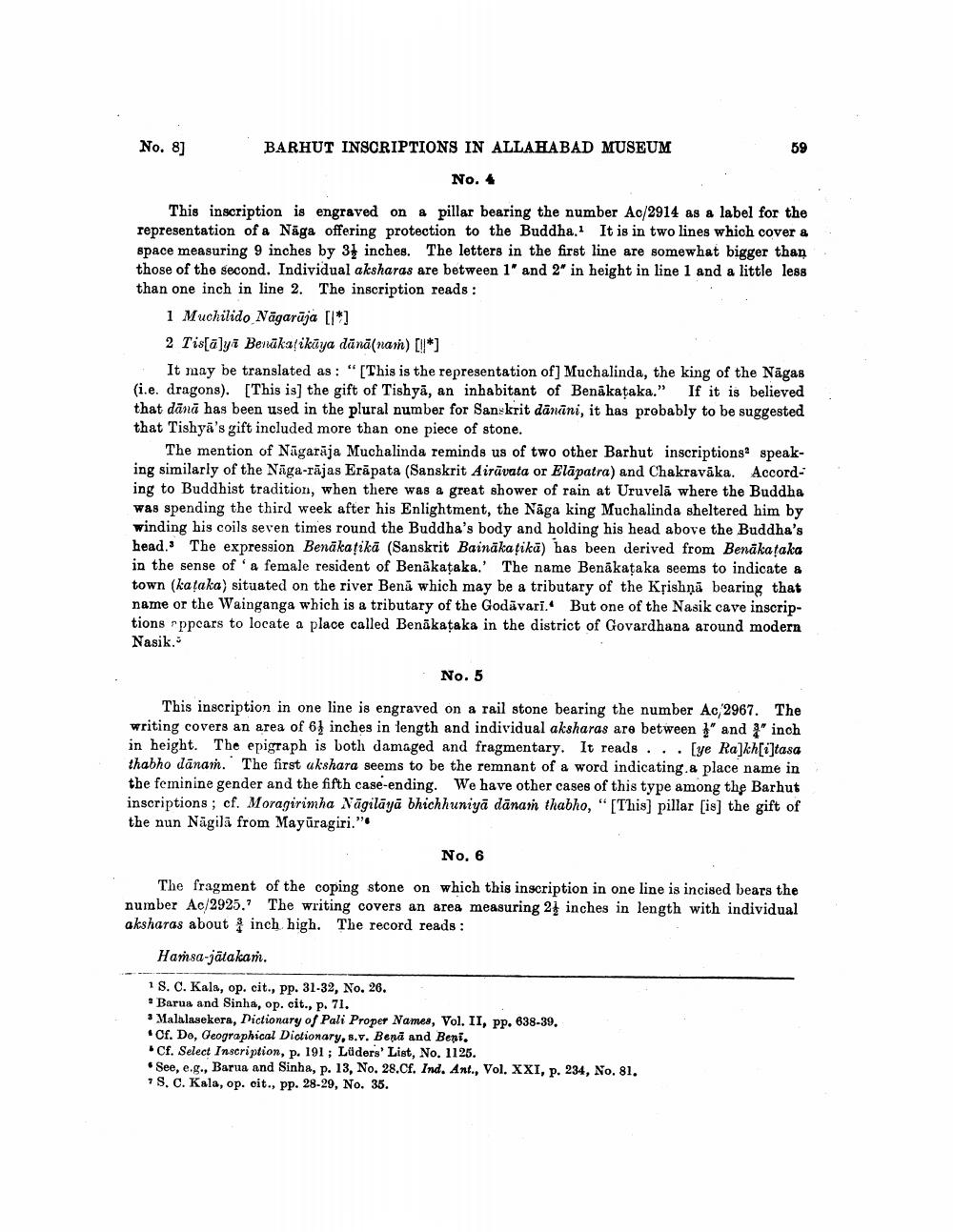________________
No. 8]
BARHUT INSCRIPTIONS IN ALLAHABAD MUSEUM
59
No. 4
This inscription is engraved on a pillar bearing the number Ac/2914 as a label for the representation of a Näga offering protection to the Buddha. It is in two lines which cover a space measuring 9 inches by 31 inches. The letters in the first line are somewhat bigger than those of the second. Individual aksharas are between 1" and 2" in height in line 1 and a little less than one inch in line 2. The inscription reads:
1 Muchilido Nāgarūja [I*] 2 Tis[w]yi Benākaļikāya dūnā(nam) []*]
It may be translated as : "[This is the representation of] Muchalinda, the king of the Nāgas (i.e. dragons). This is the gift of Tishyā, an inhabitant of Benakataka." If it is believed that dānā has been used in the plural number for Sanskrit däniini, it has probably to be suggested that Tishyā's gift included more than one piece of stone.
The mention of Nagarāja Muchalinda reminds us of two other Barhut inscriptions speaking similarly of the Näga-rājas Erāpata (Sanskrit Airāvata or Elāpatra) and Chakravāka. Accord ing to Buddhist tradition, when there was a great shower of rain at Uruvelā where the Buddha was spending the third week after his Enlightment, the Näga king Muchalinda sheltered him by winding his coils seven times round the Buddha's body and holding his head above the Buddha's head. The expression Benā katika (Sanskrit Bainākaţikā) has been derived from Benākataka in the sense of a female resident of Benākațaka.' The name Benākațaka seems to indicate a town (kataka) situated on the river Benā which may be a tributary of the Krishņū bearing that name or the Wainganga which is a tributary of the Godāvari. But one of the Nasik cave inscriptions appears to locate a place called Benākataka in the district of Govardhana around modern Nasik.
No. 5
This inscription in one line is engraved on a rail stone bearing the number Ac, 2967. The writing covers an area of 61 inches in length and individual aksharas are between l' and ' inch in height. The epigraph is both damaged and fragmentary. It reads... [ye Ra]kh[i]tasa thabho dānam.' The first ukshara seems to be the remnant of a word indicating a place name in the feminine gender and the fifth case-ending. We have other cases of this type among the Barhut inscriptions ; cf. Moragirimha Nāgilāyā bhichhuniyā dānan thabho, "[This) pillar [is] the gift of the nun Nägilā from Mayuragiri."
No. 6
The fragment of the coping stone on which this inscription in one line is incised bears the number Ac/2925.? The writing covers an area measuring 21 inches in length with individual aksharas about inch high. The record reads:
Hansa-jātakai.
1 8. c. Kala, op. cit., pp. 31-32, No. 26. . Barua and Sinha, op. cit., p. 71. • Malalasekera, Dictionary of Pali Proper Names, Vol. II, pp. 638-39. Of. Do, Geographical Dictionary, s.v. Benā and Beni. Cf. Select Inscription, p. 191; Lüders' List, No. 1125. . See, e... Barua and Sinha, p. 13, No. 28.Cf. Ind. Ant., Vol. XXI, p. 234, No. 81. :S. C. Kala, op. cit., pp. 28-29, No. 35.




